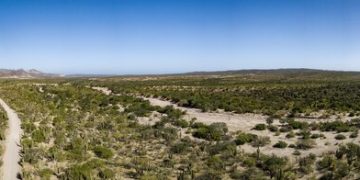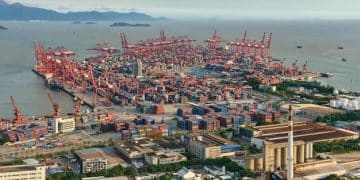US-Mexico Border Dispute: Potential Outcomes in 2025

In 2025, the US-Mexico border dispute could yield several outcomes, including increased security measures, shifts in immigration policies, economic impacts on border communities, heightened diplomatic tensions, and potential renegotiation of trade agreements.
The US-Mexico border has long been a focal point of political and social contention. Understanding what are the potential outcomes of the US-Mexico border dispute in 2025 requires examining a range of factors, from political shifts to economic pressures.
Analyzing the Current State of the US-Mexico Border
The ongoing situation at the US-Mexico border is complex, involving immigration, trade, and security concerns. Appreciating the present dynamics is essential before projecting future outcomes.
Key Issues at the Border
Several critical issues define the current state of the border. These range from migration patterns to the flow of illicit goods.
- Migration surges driven by economic hardship and instability in Central America.
- Drug trafficking and the ongoing battle against cartels.
- Trade imbalances and the economic impact on border communities.
Political Factors Influencing the Border
Political decisions in both the US and Mexico significantly shape border policies.
- US immigration policy changes under different administrations.
- Mexico’s cooperation levels in managing migration and combating cartels.
- Bilateral agreements aimed at addressing shared challenges.
Understanding these elements is crucial for forecasting the potential scenarios that might unfold. The convergence of political will, economic realities, and security imperatives will dictate the border’s future.
Possible Scenarios: Increased Security Measures
One likely outcome involves an intensification of security measures along the border. This scenario is driven by political pressure and public safety concerns.
Enhanced Border Patrol Presence
Increasing the number of border patrol agents and deploying advanced surveillance technology could be a key component.
Construction of Physical Barriers
Further construction of walls and fences along the border remains a possibility, despite controversies surrounding its effectiveness.
- Impact on wildlife and natural habitats in the border region.
- Cost-effectiveness compared to alternative security measures.
- Legal challenges related to land acquisition and environmental regulations.
Technological Advancements in Surveillance
Drones, sensors, and artificial intelligence could play a larger role in monitoring border activity.
These measures aim to deter illegal crossings and combat trafficking, but they also raise concerns about human rights and the militarization of the border.

Potential Shifts in Immigration Policies
Changes in immigration policies are another potential outcome, influenced by domestic politics and humanitarian considerations. These policies can dramatically alter the flow of people and resources across the border.
Stricter Enforcement of Immigration Laws
Increased deportations and stricter asylum application processes could become more prevalent.
Reform of Asylum and Refugee Policies
Efforts to streamline or restrict the asylum process may continue, impacting vulnerable populations.
- Legal and ethical considerations surrounding asylum seekers.
- The role of international law in shaping asylum policies.
- Capacity of the US immigration system to handle asylum claims.
DACA and DREAMers
The fate of the Deferred Action for Childhood Arrivals (DACA) program and DREAMers remains a contentious issue with significant implications for border dynamics.
Policy shifts in this arena can drastically change the demographic makeup of border communities and influence labor markets.
Economic Impacts on Border Communities
The economic health of communities along the US-Mexico border is deeply intertwined with cross-border activities. Any significant changes in border policies can have substantial economic repercussions.
Impact on Trade and Manufacturing
Disruptions to trade and manufacturing supply chains can affect employment and investment in the region.
- The role of the USMCA (United States-Mexico-Canada Agreement) in shaping trade relations.
- Potential tariffs and trade barriers affecting cross-border commerce.
- Impact on industries reliant on cross-border labor and resources.
Tourism and Cross-Border Commerce
Restrictions on border crossings can hurt tourism and local businesses dependent on cross-border shoppers.
Labor Markets and Migration
Changes in migration flows can impact labor availability and wages in border areas.
These economic factors underscore the importance of considering the practical, day-to-day consequences of border policies on the people who live and work in these communities. A balanced approach is crucial to ensure economic stability and growth.

Heightened Diplomatic Tensions
Disagreements over border security, immigration, and trade can strain relations between the US and Mexico. Diplomatic tensions can lead to further policy impasses.
Negotiating Border Security Agreements
Difficult negotiations over border security measures and immigration enforcement can create friction.
Cooperation on Drug Trafficking
The ongoing struggle against drug cartels requires a cooperative approach, but disagreements over strategy can lead to tensions.
- The Merida Initiative and its impact on bilateral security cooperation.
- Differing priorities and approaches to combating drug trafficking.
- Challenges in intelligence sharing and law enforcement coordination.
Trade Disputes and Economic Sanctions
Trade disputes and the threat of economic sanctions can further complicate the relationship.
Maintaining open lines of communication and pursuing diplomatic solutions are essential to navigating these challenges and preventing escalation.
Renegotiation of Trade Agreements
The terms of trade agreements, such as USMCA, have a direct impact on cross-border economic activity. Renegotiating these agreements could reshape the economic landscape along the border.
Potential Changes to USMCA Provisions
Revisions to provisions related to labor, environmental standards, and dispute resolution mechanisms could alter trade dynamics.
Impact on Specific Industries
Certain industries, such as agriculture and automotive manufacturing, could be particularly affected by changes to trade agreements.
- The role of lobbying and special interest groups in shaping trade policy.
- Potential winners and losers from renegotiated trade agreements.
- The impact on supply chains and regional economic integration.
Economic Implications for Border States
Border states, such as Texas and California, could experience significant economic shifts as a result of trade renegotiations.
Adaptation and strategic planning are essential for businesses and communities to effectively respond to these potential changes in the trade environment.
Conclusion: Navigating the Future of the US-Mexico Border
Predicting the exact outcomes of the US-Mexico border dispute in 2025 is challenging. The convergence of security concerns, immigration policy, economic factors, and diplomatic relations will shape the border’s future. Understanding these dynamics is crucial for policymakers and stakeholders navigating this complex landscape.
| Key Point | Brief Description |
|---|---|
| 🛡️ Increased Security | More border patrol and advanced tech. |
| 🛂 Policy Shifts | Stricter laws and asylum changes. |
| 💰 Economic Impact | Trade, manufacturing, and tourism affected. |
| 🤝 Diplomatic Tension | Disputes over security and cooperation. |
Frequently Asked Questions
▼
Economic hardship, political instability in Central America, and the desire for better opportunities in the US drive migration to the US-Mexico border.
▼
Drug trafficking fuels violence and instability, prompting increased security measures and diplomatic tensions between the US and Mexico.
▼
Trade agreements like USMCA influence economic activity along the border, affecting industries, employment, and cross-border commerce.
▼
Stricter border enforcement and asylum restrictions raise concerns about the treatment of migrants and asylum seekers, particularly vulnerable populations.
▼
Changes in US administrations can lead to significant shifts in immigration policy, border security measures, and diplomatic relations with Mexico.
Conclusion
The future of the US-Mexico border remains uncertain, with the potential for increased security, policy changes, economic shifts, and diplomatic challenges. A balanced and comprehensive approach is needed to address these complex issues effectively.





